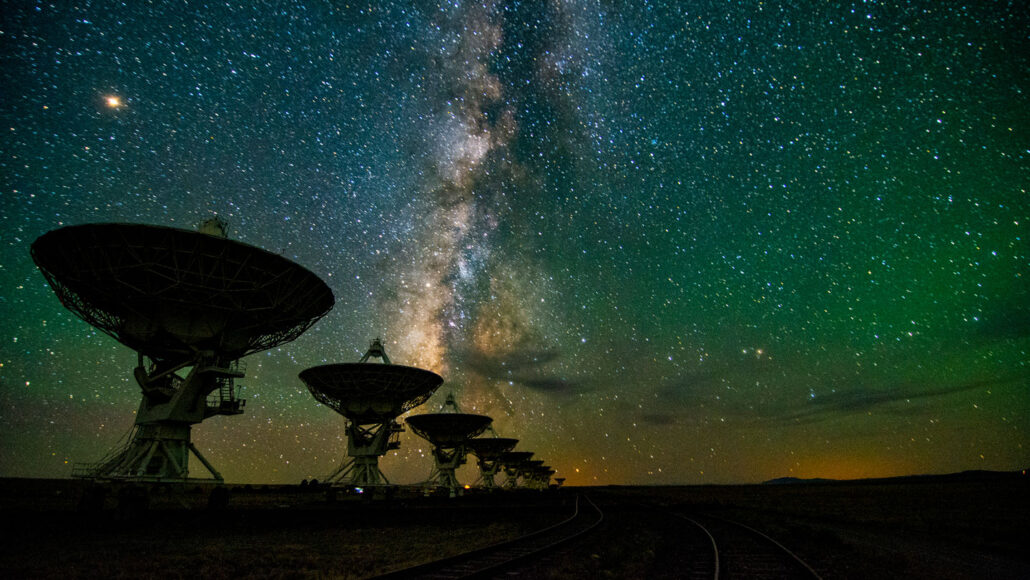Let’s learn about the hunt for alien life
The search for extraterrestrials is on, and scientists from all fields are joining the hunt

Telescopes around the world, including the Very Large Array (pictured) near Socorro, N.M., have joined the search for alien messages from outer space.
NRAO/AUI/NSF, Jeff Hellerman (CC BY 3.0)
Hunting for aliens might sound like science fiction. But it’s a serious science. Alien-seeking researchers don’t chase down UFOs, though. Some use telescopes to listen for messages broadcast by alien civilizations. Others peer at distant words for evidence of life.
No aliens have been found yet. But it’s a big universe. Astronomers have found thousands of planets orbiting other stars. And there may be billions more worlds still to be discovered. Some may even have moons that can support life. That’s a lot of potential alien real estate. Over the last 60 years, astronomers have scoured only a tiny bit of it for interstellar messages. The area searched so far is like a hot tub’s worth of water out of all the world’s oceans.
Some people think we’d have a better chance of meeting aliens if we introduce ourselves. That is, beam our own messages into space. These messages could be written in mathematical patterns. (Math is thought to be a universal language.) One such message was sent from the Arecibo telescope in Puerto Rico in 1974. But other scientists say this is a bad idea. We might not want to advertise our existence to unfriendly aliens.
There may also be aliens that aren’t able to send or read messages. Some planets may be home to simple, even microscopic life forms. To find those worlds, astronomers look for new worlds in the so-called habitable zone. This is the area around a star where a planet would be just warm enough to have liquid water. That’s important because water is essential for all known life. One such planet may orbit the nearest star to our sun.
A planet may not have to look just like Earth, though, to be a good home for aliens. Some hardy creatures on our own planet thrive in seemingly unlivable conditions. Microbes at the seafloor bask in scalding water. Meanwhile, microbes nestled in Antarctic ice withstand freezing cold. Other critters slurp up toxic chemicals or bathe in acid. Learning about these “extremophiles” broadens our view of what places in the cosmos might be livable.
Microbial aliens might also be found closer to home. Saturn’s moon Enceladus is a good place to look. So is Jupiter’s moon Europa. Both have oceans of liquid water encased in their icy crusts. Mars could even host life in a lake near its south pole. A recent survey suggested that most Americans would welcome finding alien microbes.
The question of whether we are alone in the universe has captured people’s imaginations for millennia. And the answer has two equally mind-blowing possibilities. In all the vast expanse of outer space, either we are completely alone — or we are not.
Want to know more? We’ve got some stories to get you started:
World’s deepest zoo harbors clues to extraterrestrial life Scientists have found a wide range of life deep below Earth’s surface. Those discoveries could inform the search for life on other planets. (6/15/2017) Readability: 6.6
Only a small fraction of space has been searched for aliens How little? A volume equivalent to a hot tub’s worth of the Earth’s oceans. (10/24/2018) Readability: 8.2
Should we call out to space aliens? To speed up the search for extraterrestrials, some scientists recommend sending signals to space. Others disagree. (3/21/2017) Readability: 8.0
Explore more
Profile: Looking for life beyond the solar system
Keeping space missions from infecting Earth and other worlds
Finding living Martians just got a bit more believable
Most Americans would welcome a microbial E.T.
Will we know alien life when we see it?
A trail of cosmic dust may lead to alien life
Planets with hydrogen skies could harbor life
Cool Jobs: Reaching out to E.T. is a numbers game
Activities
The message to alien civilizations sent out by the Arecibo Radio Telescope in 1974 was a picture. It included a basic sketch of a person, the solar system and other information. But in order to beam that picture into space, scientists had to translate it into binary code. That’s a series of 1s and 0s. Learn how to read and create your own binary code messages with this activity from the Rio Tinto Alcan Planetarium in Montreal, Canada.







